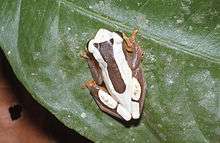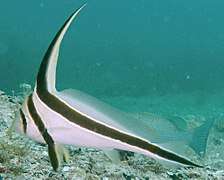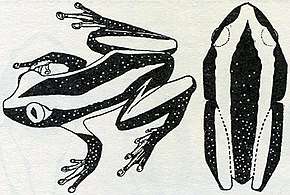Coincident disruptive coloration
Coincident disruptive coloration or coincident disruptive patterns are patterns of disruptive coloration in animals that go beyond the usual camouflage function of breaking up the continuity of an animal's shape, to join up parts of the body that are separate. This is seen in extreme form in frogs such as Afrixalus fornasini where the camouflage pattern extends across the body, head, and all four limbs, making the animal look quite unlike a frog when at rest with the limbs tucked in.
A special case is the disruptive eye mask that camouflages the most conspicuous feature of many animals, the eye.
Camouflage mechanism

The English zoologist and camouflage expert Hugh Cott explained, while discussing "a little frog known as Megalixalus fornasinii" in the chapter on coincident disruptive coloration in his 1940 book Adaptive Coloration in Animals, that[2]
It is only when the pattern is considered in relation to the frog's normal attitude of rest that its remarkable nature becomes apparent... The attitude and very striking colour-scheme thus combine to produce an extraordinary effect, whose deceptive appearance depends upon the breaking up of the entire form into two strongly contrasted areas of brown and white. Considered separately, neither part resembles part of a frog. Together in nature the white configuration alone is conspicuous. This stands out and distracts the observer's attention from the true form and contour of the body and appendages on which it is superimposed.[2]
Cott concluded that the effect was concealment "so long as the false configuration is recognized in preference to the real one".[2]
_Oak_Beauty_(Biston_strataria)_(cropped).jpg)
The effect is seen also in the common frog, Rana temporaria, in which the dark and light bands that cross the body and hind legs coincide in the resting position, and in several moths[3] such as the oak beauty, Biston strataria, in which the forewing pattern coincides with the pattern on the narrow strip of the hindwing which is visible in the moth's habitual resting position.[4] Cephalopods are capable of active camouflage, by day used for signalling as well as camouflage; at night, 86% of giant Australian cuttlefish, Sepia apama, were seen to select camouflage patterns, most often (41%) disruptive, the patterns coinciding across the cuttlefish's body parts.[5]
The effect was tested in two experiments in 2009 by Innes Cuthill and Aron Székely; they found in both cases that it was "an effective mechanism for concealing an otherwise revealing body form".[6][7]
A special case: disruptive eye mask

One form of coincident disruptive coloration has special importance. Disruptive eye masks camouflage the eyes of a variety of animals, both invertebrates such as grasshoppers and vertebrates such as fishes, frogs, birds and snakes; some mammals have similar patterns. The eye has a distinctive shape and dark coloration dictated by its function, and it is housed in the vulnerable head, making it a natural target for predators. It can be camouflaged by a suitable disruptive pattern arranged to run up to or through the eye, such as the camouflage eyestripe of the Mexican vine snake and certain fishes.[2][8][9]
Evidence for natural selection
In the words of the camouflage researchers Innes Cuthill and A. Székely, Cott's book provided "persuasive arguments for the survival value of coloration, and for adaptation in general, at a time when natural selection was far from universally accepted within evolutionary biology."[1] In particular, they argued, Cott's category of "Coincident Disruptive Coloration" "made Cott's drawings the most compelling evidence for natural selection enhancing survival through disruptive camouflage."[1] Such patterns embody, as Cott stressed, considerable precision as the markings must line up accurately for the disguise to work. Cott's description and in particular his drawings convinced biologists that the markings, and hence the camouflage, must have survival value (rather than occurring by chance); and further, as Cuthill and Székely indicate, that the bodies of animals that have such patterns must indeed have been shaped by natural selection.[1]
References
- 1 2 3 4 Cuthill, I. C.; Székely, A. (2011). Stevens, Martin; Merilaita, Sami, ed. Animal Camouflage: Mechanisms and Function. Cambridge University Press. p. 50. ISBN 978-1-139-49623-0.
- 1 2 3 4 5 Cott, Hugh B. (1940). Adaptive Coloration in Animals. Methuen. pp. 68–72.
- ↑ Evans, David L. (1983). "Relative Defensive Behavior of Some Moths and the Implications to Predator-Prey Interactions". Entomologia Experimentalis et Applicata. 33 (1): 103–111. doi:10.1111/j.1570-7458.1983.tb03240.x.
- ↑ Cloudsley-Thompson, John Leonard (1989). "Some Aspects of Camouflage in Animals" (PDF). Qatar Univ. Sci. Bull. 9: 141–158.
- ↑ Hanlon, Roger T.; Naud, Marie‐José; Forsythe, John W.; Hall, Karina; Watson, Anya C.; McKechnie, Joy (2007). "Adaptable Night Camouflage by Cuttlefish". The American Naturalist. 169 (4): 543–551. doi:10.1086/512106.
- ↑ Cuthill, I. C.; Szekely, A. (2009). "Coincident disruptive coloration". Philosophical Transactions of the Royal Society B: Biological Sciences. 364 (1516): 489–496. doi:10.1098/rstb.2008.0266. PMC 2674087.
- ↑ Stevens, Martin; Cuthill, Innes C.; Alejandro Párraga, C.; Troscianko, Tom (2006). "Chapter 4 The effectiveness of disruptive coloration as a concealment strategy". 155: 49–64. doi:10.1016/S0079-6123(06)55004-6.
- ↑ Barlow, G. W. (1972). "The attitude of fish eye-lines in relation to body shape and to stripes and bars". Copeia. 1972: 4–12. JSTOR 1442777.
- ↑ Gavish, Leah; Gavish, Benjamin (1981). "Patterns that conceal a bird's eye". Z. Tierpsychol. 56: 193–204.

.jpg)